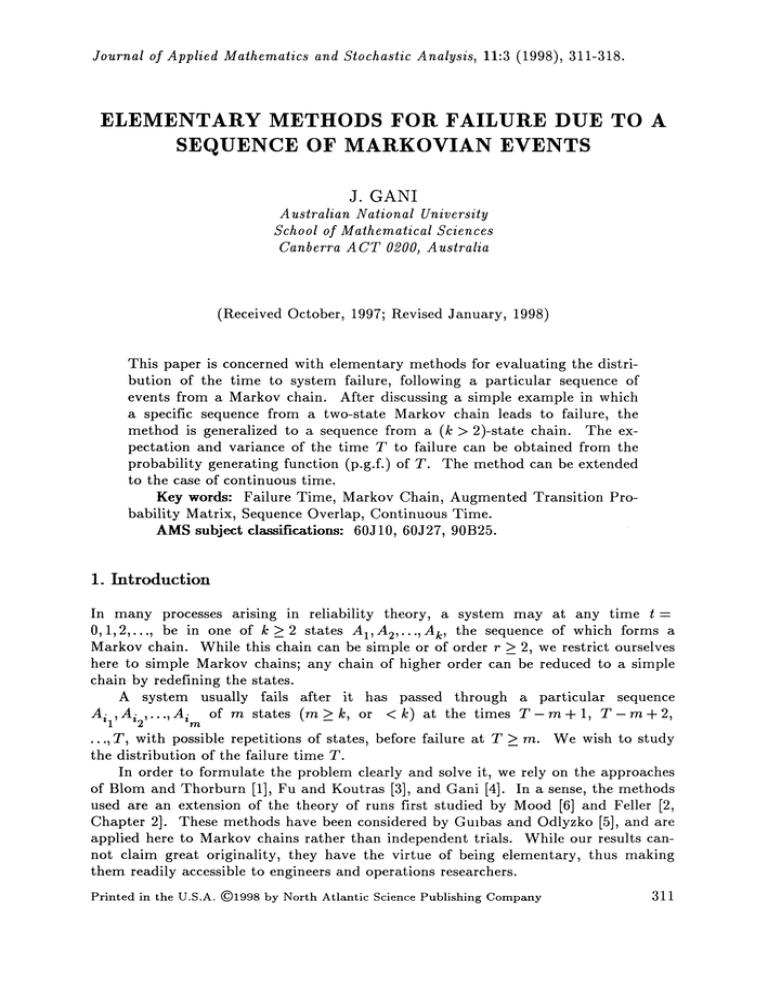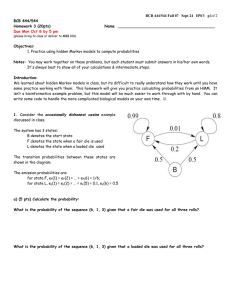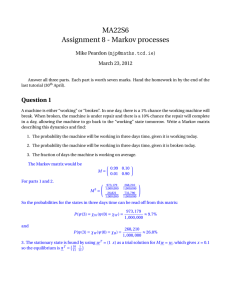SEQUENCE ELEMENTARY FAILURE DUE A
advertisement

Journal
of Applied Mathematics
and Stochastic Analysis, 11:3
(1998), 311-318.
ELEMENTARY METHODS FOR FAILURE DUE TO A
SEQUENCE OF MARKOVIAN EVENTS
J. GANI
Australian National University
School of Mathematical Sciences
Canberra ACT 0200, Australia
(Received October, 1997; Revised January, 1998)
This paper is concerned with elementary methods for evaluating the distribution of the time to system failure, following a particular sequence of
events from a Markov chain. After discussing a simple example in which
a specific sequence from a two-state Markov chain leads to failure, the
method is .generalized to a sequence from a (k > 2)-state chain. The expectation and variance of the time T to failure can be obtained from the
probability generating function (p.g.f.) of T. The method can be extended
to the case of continuous time.
Key words: Failure Time, Markov Chain, Augmented Transition Probability Matrix, Sequence Overlap, Continuous Time.
AMS subject classifications: 60J10, 60J27, 90B25.
1. Introduction
In many processes arising in reliability theory, a system may at any time t0,1,2,..., be in one of k_> 2 states A1,A2,...,Ak, the sequence of which forms a
Markov chain. While this chain can be simple or of order r >_ 2, we restrict ourselves
here to simple Markov chains; any chain of higher order can be reduced to a simple
chain by redefining the states.
A system usually fails after it has passed through a particular sequence
of m states (m _> k, or < k) at the times T- m + 1, T- m + 2,
,.. .,
All, Ai2
Aim
...,T, with possible repetitions of states, before failure at T >_ m. We wish to study
the distribution of the failure time T.
In order to formulate the problem clearly and solve it, we rely on the approaches
of Blom and Thorburn [1], Fu and Koutras [3], and Gani [4]. In a sense, the methods
used are an extension of the theory of runs first studied by Mood [6] and Feller [2,
Chapter 2]. These methods have been considered by Gmbas and Odlyzko [5], and are
applied here to Markov chains rather than independent trials. While our results cannot claim great originality, they have the virtue of being elementary, thus making
them readily accessible to engineers and operations researchers.
Printed in the U.S.A.
()1998 by North
Atlantic Science Publishing Company
311
J. GANI
312
2. The Case of the 2-State Chain
A1,A 2
When k- 2, we may for simplicity label the states
Markov chain with transition probability matrix
Xn+ 1
as
0, 1, forming the simple
1
0
0
Xn
PO0 POl
1
PlO Pll
and initial probabilities [Po, Pl] where P{X o -O} Po, P{Xo- 1} Pl"
Let us assume that failure occurs when the sequence 010 arises for the first time.
We now form an augmented transition probability matrix for the states O, 1, 01,010,
this last being an absorbing state:
Xn+ 1
0
1
01
010
1
PO0
0
P01
0
1
Pll
0
0
01
PlO
0
Pll
0
PlO
010
0
0
0
1
If we denote the initial probability vector by
the failure time
(2.2)
p’-[P0Pl 0 ], we can readily see that
T010 will have the probability distribution
P{Tol o n} p,pn-2Q,
n
>_ 2,
(2.3)
where in fact this probability is 0 for n < 3.
The probability generating function (p.g.f.) of Tmo is
f010 (0)
E P’O(PO)n-2QO,
0
< 0 <_
(2.4)
1.
n--2
This can be derived explicitly as
f010(O)
p’O[I PO]- 1QO
1
o
PO[
2
Plo 0
PolP11 0
1 Poo 0
PloP11 02
(1 PooO)Pll 0
1
Pll 0
-[.o0 pl 0
PolO(1 Pll O)
PolPlo 02
(1 PooO)(1 Pll 0
03[PoPolPlO + O(PlPolPo PoPo1P10P11)]
1
(Po0 + P11) 0 -[- PooP11 02 Po1P10P11 03"
0
0
Pl o 0
Elementary Methods for Failure Due to a Sequence of Markovian Events
One can easily find the expectation and variance of TOl o from (2.5)
313
as
E(Tolo) f)lO(1), V(Tolo) flo(1) + f)lO(1) (f)lO(1)) 2.
Such calculations can be tedious if the full notation is retained, but become simpler if
specific values are used for the probabilities, as in the following example.
Example 2.1: Let Po-P1-0"5, Poo-0"7 and POl-0"3, PLO-0"4 and P11-0.6; we then find from (2.5) that
"fl(0)
fl(0)
flo(0
03[0.06 -0.120]
1
1.30 4- 0.4202
0210.18
0.07203,
0.2040 + 0.07202 0.0!00803.4- 0.00086404]
[1 1.30 4- 0.4202- 0.07203] 2
(2.7)
0[0.36 0.6120 4- 0.40202 0.1000803 4- 0.00043204 0.001859205]
[1 1.30 + 0.4202 0.07203] 3
It follows that
E(Tolo) f’olo(1)
16.8333,
(2.8)
V(Tolo) f1o(1) +/1o(1)- (/1o(1)) 2 205.5788,
so that
r(Too)= 14.3380.
This indicates how large the variation can be in the time To1 o until failure
occurs; the range of E(Tolo) + r(Tolo) is 2.4953 to 31.1713, with To1 o _> 3. It should
be pointed out that if the sequence required for failure had been 000, the augmented
transition probability matrix would have been
Xn + 1
PlO
O0
000
1
O0
PO1
PO0
Pll
0
PO1
0
0
0
0
0
000
(2.9)
Poo
with the same transition probabilities as in (2.1), and the same initial probabilities Po
and Pl" The submatrices P, Q of (2.9) are now different from those in (2.2), with the
result that the p.g.f, fooo(O) of
o differs from folo(0) of (2.5), as do also the
relevant expectation and standard deviation.
Too
3. An m-Sequence of States for k > 2
Let
us now suppose that the sequence of states
where these m states
(mk k,
or
< k)
leading to failure is
are selected from among the k
AilAi2...Aim
> 2 states
J. GANI
314
These form a Markov chain with transition probability matrix
A2,...,A k.
Xn +
A1
A1
A2
Ak
Pll
P12
Plk
P21
P22
P2k
Pkl
Pk2
Pkk
(3.1)
and initial probabilities Pi- P{Xo- i}, i- 1,...,k. We consider the augmented
transition probability matrix for the states A1, A2,... Ak, A
1
this last being an absorbing state"
Ai2, AilAi2Ai3,..
AilAi2...Aim
Xn + 1 AI"" "All’" "Ai2"" "Ai3"" "Ak Ai I Ai 2 Ai I Ai 2 Ai3"" "All"" "Ai
Xn
A1
Pll Pli I Pli 2 Pli 3 Plk
Ai 1
Pill Pill I
Ai 2
Pi21 Pi2i I Pi2i 2 Pi2i3 Pi2k
0
Ak
Pk 1 Pki I Pki 2 Pki 3 Pkk
0
AilAi
AilAi2Ai
0
0
Pill3 Pilk Pill 2
0
2
3
0
0
0
Pi2i 3
(See text for positioning of probabilities)
All"" "Aim
All...Ai
Pim_li m
0... 0... 0... 0...
0
m
(3.2)
We note that in the submatrix for the states
A1,...,Ail,...,Ai2,...,Ai3,...,Ak, all
probabilities except
Pili 2 are positioned as in (3.1), but P{A il--,AilAi2} is Pqi2 positioned at (il, ili2) so that P{AilAi2}-O at (i1,i2).
Next, P{AilA.2-4
AilAi2Ai3}-Pi2i3 is positioned at (ili2, ili2i3) so that P{AilAi2---.Ai3}-O at
(ili2, i3). Also, if AqAi2 is AilAil and the next state is also Ail, then AilAi2Ail
AilAilAil with the last 2 states overlapping the first two.
P{A All "*AilAil }- Pilil
1
In this case
(3.3)
Elementary Methods for Failure Due to a Sequence
is positioned at
of Markovian Events
315
P{AilAil---Ail}- O.
(ilil,ilil) with
We outline a general method for allocating the transition probabilities in the
lower part of the matrix (3.2) for the states
Suppose we are
in the state X n
Ail...Aij
AilAi2,.. All..A
Ail...AijA1, Ail...AijA2,...
then X n +
All’" "AijAij + 1’ "’ All’" "AliA
k.
will be one of
Clearly
__
(3.4)
P{Ai" "’Aij-Ail"’AijAij +1}- Pijij +1
will be positioned at (i 1. .ij, 1. .ijij + 1) with P{Ail...A
ij--Aj. + 1} 0 at
(il’"ij, ij + 1)" For all other states of X n + 1 not ending with Aij + 1’ we have in the
position (ill .ij,1) the probability
2.
(l
.Aij- At} Pijl
P{Ai 1.
ij +
with the following exceptions. For some values of r (2
overlap between the first and last j + 2- r states of
r
(3.5)
j) there may be
an
AilAi2...Air...A 3.At, so that
AilAi2""Aij -[- 2
In this case, the probability
_
the consequence that
r
Ai
(3.6)
"’AijAl"
Pijl is allocated to the position (il...ij, il...ij + 2- r) with
P{Aq...AijAI}- O.
Once the matrix (3.2) is fully defined, we have that the time to failure
follows the distribution
P{Tqi2...im
p,pn-2Q,
n}
n
>_ 2.
Tili2...i
m
(3.7)
Here p’ [Pl P2
Pk 0...0] is the 1 (k + rn- 2) vector of initial probabilities, P is
the (k + m- 2) (k + m- 2) matrix in (3.2) and Q the (k + m- 2) 1 column vector
Note that
with zero components, except for the last row whose entry is Pi
T
il...i m
m--1
m.
The p.g.f,
ira.
f il." .ira(O) of Til...i m is
f il.
.im(O
p’O[I PO]- 1QO
which can, in principle, be evaluated if the structure of P is known. But it is clearly
not possible to give an explicit result which will hold generally.
Perhaps the procedure is best illustrated by an example for a Markov chain with
k 3 states A1,A2, A3, and a sequence of m--3 states, say A2A2A3, leading to
failure. The basic transition probability matrix is
Xn + 1
A1
Xn- A2
A3
A1 A2
A3
P13
P21
P12
P22
P31
P32
P33
Pll
P23
(3.9)
J. GANI
316
with initial probabilities P{X 0 Ai} pi, i- 1, 2,3. The augmented matrix for the
states A1, A2, A3, A2A2, A2A2A 3 is given by
Xn + 1
A1
A2
A3
A2A 2
A2A2A 3
A1
A2
A3 A2A 2 A2A2A 3
Pll
P12
P13
0
P21
P31
0
P23
P22
P32
0
P21
0
P33
0
P22
P23
0
0
0
0
1
0
P
011
(3.10)
Note that P{A2-,A2A2} P22 with the consequence that P{A2--A2} 0; also, in
going from X n -A2A 2 to X n + 1- A2A2A2, since the last A2A 2 of X n + 1 overlap
the A2A 2 of Xn, we have P{A2A2A2A2} = P22 with P(A2A2--,A2} O.
Exactly as in (3.7), the distribution of the failure time T223 is
P{T223 -n}- [Pl P2 P3 0] P"-2Q, n _> 2,
where this probability is 0 for n
f223 (0)
< 3. The p.g.f,
(3.11)
of T223 is
E [Pl 0 P20 P30 O](PO)n-2QO,
n--2
p’O[I-PO]-IQO,
In its explicit form, this is
f223(0)
[plY9 p20 p30 0]
1
PO[
(3.12)
0<0<1.
A14
A24
A34
(3.13)
P230
where the dots indicate that the values of these elements are irrelevant to our calculations. We find that
A14 --0 2 [P13 P22 P32 0 "4-P12 P22 (1- P330)],
A24 0[P22(1 Pll 0) (1 P330) P13 P22 P3102],
(3.14)
A34 02[P12 P22 P310 + P22 P32( 1 P110)],
II- POI (1 p220)[(1 p110)(1 P330)
--02{P13 P31 + P12 P21( 1 P330) -f P23P32( 1 P110)}
--03(P12 P23 P31 + P13 P21 P32)] P22 P21 03 [P13 P320 A-P12(1- P330)].
Elementary Methods for Failure Due to a Sequence
of Markovian Events
317
This finally yields
P23PlO2A14 + P23P202A24 + P23P302A34
f223(0)
(3.15)
]I- PO
where the numerator is 03 times a quadratic polynomial, and ]I-PO] is a quartic
polynomial. Once again, we use specific values of the probabilities to illustrate our
procedure by an example.
Example 3.1" Let Pl- P2- P3- 0.3333, and the matrix (3.7) be
0.4 0.3 0.3
(3.16)
0.6 0.3 0.1
0.5 0.2 0.3
It follows from (3.13) that
f223(0)
1
0.0099903[ 1 0.20 + 0.0102]
0 0.0202 + 0.02603 + 0.002104.
By differentiating f223(0) and its first derivative,
E(T223) f23(1)
we obtain
120.3857,
V(T223) f’23(1) + f23(1)- (f23(1)) 2
so that
(3.17)
(3.18)
13960.5636,
tr(T223)- 118.1548.
Once again,
as in Example
E(T223)-4-r(T223)
2.1, the variation in T223 is very large; the range of
is 2.2309 to 238.5405, with T223 _> 3.
4. The Continuous Time Case
In most reliability problems, events occur in continuous time t >_ 0, with changes of
state arising at points arriving in a Poisson process with parameter A. The discrete
time process of Section 3 may be regarded as one embedded in the Poisson process.
lies in (t,t +St) after
In this case, the probability that the failure time
Tili2...i
states
AilAi2...Aim
g(t)St
m
have occurred in this sequence for the first time, will be
c
P{t < Til...i m < + St}
E
e
_,t(At)n-1 A[p’P
n:2
(n-1
- -.
2Q]St,
(4.1)
where p’ [Pl P2" "Pk 0 0...0] is a 1 (k + m- 2) vector of initial probabilities, P is
the (k/m-2) x(k+m-2) matrix in (3.2) and Q the (k+m-2)l column
vector whose single non-zero entry is Pim_lim in the last row.
It is simpler to deal with the Laplace transform in (4.1); this is given by
n
2
(n 1)! A[P’Pn-
2Q]dt’
Re s >_ O,
.
J. GANI
318
n= 2
+ s p,pn-2Q
,+s p’
I-.+Ps
Q"
We proceed to illustrate its use by an example.
Example 4.1: We refer to the Example 2.1, which we now reconsider in continuous time, the changes of state occurring at the points of a Poisson process with
parameter
.
The Laplace transform of the failure time
( )3
Thus, the distribution of
0.06
1
T010
1.3 ),+ +
T010 in this case is
0.012 / s
0.42(+)
-0.072
(+)a
(4.3)
is an infinite sum of gamma type variables starting
with those having Laplace transforms
0.06
(+
-0.012
(+s
or probability density functions
0.06 A
(A2t!)
2
e
)t
-0.012
3t!)3e
t.
(4.4)
The next set of terms will be
0.078
()t3t!)3e-’Xt
0 0156 A
(’t)4 e- ,Xt,
4!
(4.5)
as we begin to expand the denominator of (4.3). While the method is simple to describe, it is rather intractable when k and m are large.
References
[1]
[2]
[4]
[5]
[6]
Blom, G. and Thorburn, D., How many random digits are required until given
sequences are obtained, J. Appl. Prob. 19 (1982), 518-531.
Feller, W., An Introduction to Probability Theory and its Applications, 3rd Ed.,
Wiley, New York 1968.
Fu, J.C. and Koutras, M.V., Distribution theory of runs: a Markov chain
approach, J. Amer. Statist. Assoc. 89 (1994), 1050-1058.
Gani, J., On sequences of events with repetitions, Stoch. Models 14 (1998), to
appear.
Guibas, L.J. and Odlyzko, A.M., String overlaps, pattern matching and nontransitive games, J. Combin. Theory A30 (1981), 181-208.
Mood, A.M., The distribution theory of runs, Ann. Math. Statist. 11 (1940),
367-392.







